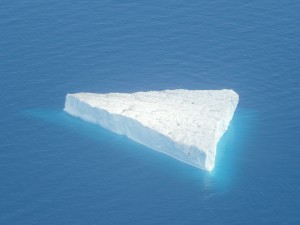Sea ice still on the decline
September is the month when the Arctic ice reaches its lowest exten t before the onset of winter. And it probably won’t surprise you to know that the trend has not changed. The minimum ice extent was the second lowest in satellite records after the low of 2007, according to the National Snow and Ice Data Centre, continuing what’s knows as the “decadal trend of rapidly decreasing summer sea ice”. NSIDC says this is a preliminary announcement and the sad 2007 record may yet be beaten, as conditions will still change until early October.
t before the onset of winter. And it probably won’t surprise you to know that the trend has not changed. The minimum ice extent was the second lowest in satellite records after the low of 2007, according to the National Snow and Ice Data Centre, continuing what’s knows as the “decadal trend of rapidly decreasing summer sea ice”. NSIDC says this is a preliminary announcement and the sad 2007 record may yet be beaten, as conditions will still change until early October.
There is a Greenpeace expedition on board the Arctic Sunrise currently up in the Arctic, led by campaigner Frida Bengtsson. Let me quote you her response to the latest figures:
“This is a clear signal of how climate change is causing the rapid shrinking of Arctic sea ice extent. It not only has grave implications for the polar bears and other wildlife that depend on the sea ice, but for the planet as a whole – an Arctic free of summer sea ice could destabilise global weather patterns”.
She says the news should alarm world leaders at a time when countries and companies are rushing to expoloit newly uncovered areas of the Arctic Ocean. Meanwhile, there is no real sign of a major breakthrough in international climate negotiations.
Till Wagner, an ice scientist from the University of Cambridge’s Polar Ocean Physics Group, also aboard the Arctic Sunrise, said the team was seeing ” a staggering retreat in the ice. The speed and the scale at which the sea ice is diminishing cannot be explained by extreme weather conditions or similar theories. It is a direct consequence of global rising temperatures that lead to the heating up of the air and of the oceans.”
The 2007 record low was reached during a period of extreme local weather conditions where unusual temperatures, winds and currents combined to accelerate and increase ice melt. The fact that this year’s ice has retreated almost as much although conditions are less extreme indicates that large parts of the ice pack are weak and thin and that Arctic sea ice is on a long-term decline, according to the Cambridge scientists, who are conducting research into the thickness and volume of the sea ice.
Sea ice thickness is key to exposing the impact of climate change on the Arctic and overall stability of the ice cover, because older ice grows thicker over multiple seasons, while newly formed ice, which is replacing the old thick ice, tends to be thinner and more vulnerable to melting in the summer.















